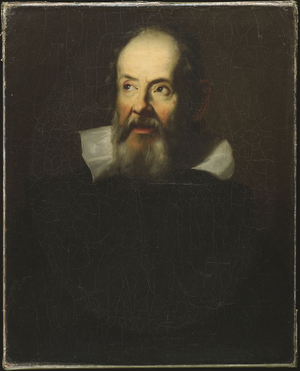
Image Credit: William Tolman Carlton, after Justus Sustermans
Earliest source: "Galileo Galilei (1564-1642), after Justus Suttermans [sic]." Harvard Portrait/Clock Collections. Harvard Libraries, HUAM311240
I'm not generally including images for background notes that are not directly related to Harvard, however in this case this portrait is actually at Harvard, on display at the Observatory. The image is a copy of a famous portrait by Justus Sustermans, which is on display at the Uffizi Gallery in Florence Italy (where Galileo was under house arrest while sitting for the portrait in 1636).
This painting has been extensively copied, and googling for Galileo and Sustermans yields a vast array of copies of varying quality, often attributed directly to Sustermans. Harvard owns two of these copies, this one by William Toman Carlton (incorrectly attributed as "Carleton" in some sources) was given to the Observatory in 1890 after the artist's death. The other copy was previously owned by E. C. Pickering, and bequeathed to Harvard in 1919.
If you do search on google, you might notice that you find two distinct families of copies of the Susterman portrait. There are those like this one, of a disembodied head looking off to the side, and another series of him seated, eyes forward, holding a telescope. And looking even more grumpy. The original of that portrait is from Palazzo Pandolfini in Florence and is currently somewhere at the Royal Museums Greenwich. It is likely also painted by Justus Sustermans himself, perhaps around 1640 or perhaps after Galileo's death in 1642. If it is by Sustermans, it's not clear if it was based on a later sitting, or if Sustermans simply copied and expanded on his earlier work.rmgblog
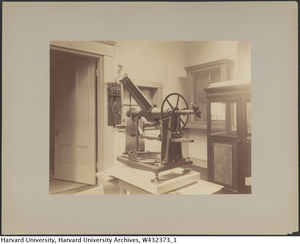
This is the "Portable Transit Instrument" obtained in 1870.annals8 It is shown in the West Transit room, identified by the wiring panel found in other images, and the interior window found on some building plans. It's was on the same pier as the four foot transit instrument described in the first Annals.annals8 annals1
The instrument was made for Harvard by the Pulkovo Observatory, under their "mechanician" Mr. Herbst, under the direction of Otto von Struve.annals8
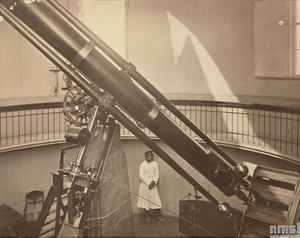
Earliest source: "Photograph of a large equatorial by Merz and Mahler." Science Museum Group / Collections Online - Objects. Science Museum Group, 2015.nmsipulkovo
This is the only photo I've found of the older twin to our Great Refractor - the 15" Refractor at the Pulkovo Astronomical Observatory (note that the Russian "Пулково" is also sometimes transliterated as "Pulkova" or "Pulcova"). This telescope had first light in 1839, and was the largest telescope in the world (along with ours in 1847) until 1862, when Dearborn Observatory erected an 18.5 inch. (and I'm not counting the much larger Craig telescope from 1852, because it had serious flaws that prevented effective use).
The design is similar to many other Merz and Mahler telescopes. The Naval Observatory has (or had) a 9.62" refractor that looks remarkably like a miniature version of our telescope (with a full-sized pier). There is also a similar refractor in Palermo, and I'm sure many others as well. They're all the same family but this is the only twin.
There seem to be other parallels between the two observatories. The original building design of our observatory resembles early Pulkovo perhaps more than any other observatory I've seen—a large central building, with two wings, and smaller buildings at the end of each wing. Both use triangular pediments on both the end buildings and central building. Like our observatory, Pulkovo seems to place transit instruments in the connecting structures leading out to the wings.wikipulkovo
I'm not sure who the man is in the photo. Otto Von Struve would be a logical guess, and he did have the bushy sideburns, but this man's complexion seems much darker, and I see no other photos of Struve with a mustache.
Pulkovo observatory was bombed into oblivion during World War II, but some instruments and lenses were saved, including a 30" lens from Alvan Clark & Sons from 1885 (and with that telescope Pulkovo had the largest telescope in the world for a second time). Sources seem inconsistent on whether the 15" Merz and Mahler lens was saved.wikipulkovo
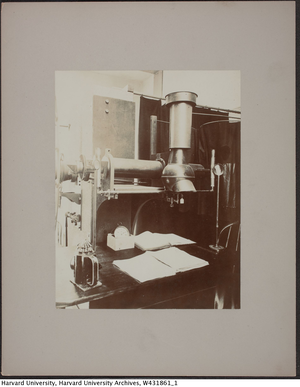
Earliest source: "[Apparatus]." Harvard University Archives / UAV 630.271 (209). Harvard Libraries, olvwork431861
[Apparatus]
ca. 1910-1930
Creator: Harvard College Observatory, Cambridge
This photograph matches an engraving used as the frontispiece in Annals volume 14.annals14, where it is referred to as "General View of Meridian Photometer". This measures the brightness of stars, by comparing any given (relatively northern) star next to the North Star, allowing you to adjust the brightness of either star until the match, and measure the ammount of dimming required for that match. This was a completley independent device, unlike most other photometers used by Harvard, which were complicated eyepieces for existing telescopes.
The Observatory went on to build at least two other Meridian Photometers, a four inch model used from about 1882 to 1890, and a twelve inch used extensively after that.
The object on the near left corner of the table is a boat signal lamp, a lantern with a lens on one side. Or in modern terms, a flashlight.
This device is the leading contender for "Photometer P" from Observatory Pinafore.
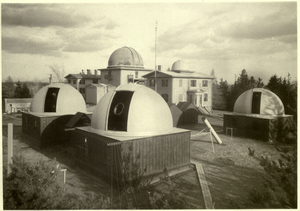
Earliest source: Edward C. Pickering. Henry Draper Memorial / Second Annual Report of the Photographic Study of Stellar Spectra vol. 2. John Wilson and Son, 1888.draperreport1888
This is one of the highest quality scans of an early image I have of the observatory. It's so good that I think it may have been a pasted-in photo. There's no signs of a halftone screen, and as far as I can tell (not an expert), no signs of photogravure techniques used around this time.
The source describes the buildings. I'll just quote it directly:
"The present location of the various instruments is shown in the Frontispiece to this Report. It represents the rear of the Harvard College Observatory, and is taken from the top of a cottage to the northwest of the main building. Of the three domes in the foreground the right-hand one contains the 11-inch photographic telescope, and the central one the 28-inch reflector. The 15-inch reflector has been attached to the tube standing between the two domes. The 8-inch telescope is mounted in the shed between the central dome and the dome to the left, which contains a 13-inch and a 10-inch photographic telescope. The east wing of the main building is to the right, and is mainly devoted to the computing work described below. The cottage from which the picture is taken contains a large dark room, in which all the photographs are developed, an adjoining room for general experimenting, a room for clerical work, and a room which may be darkened and light thrown in by a mirror ; this room is used for enlargements and other experimental work." [I think "east wing" should be "west wing".]
Note that the end there describes the "cottage" where so many photos were taken. This fills in a bit of information for me, but doesn't necessarily match other photos I have that show this "cottage" from other angles [coming soon]. It's also not consistent with a later description that says the enlarging apparatus is in a "low one story buidling with a flat roof".annals32p1
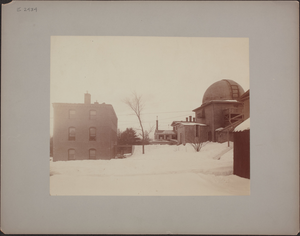
Earliest source: "[View of Harvard College Observatory in winter, photgraph] ." Harvard University Archives / UAV 630.271 (E2434). Harvard Libraries, olvwork432391
At first I just loved this as a very unusual angle compared to anything else I've found, and because it shows a bridge connecting to the brick building that I haven't seen elsewhere. Then I realized it might be a lot more significant.
Take a close look to the right of the center of the image - there appears to be a box hanging from a rope strung between buildings, in front of the windows of the distant building.
According to the Director's annual report of 1893:
"On March 2, 1893, a transfer was made of a large portion of the contents of the west wing of the main building of the Observatory to the new brick building. Nearly thirty thousand glass photographic plates were transferred from one building to the other without serious accident. The greater number of plates measured eight by ten incnes and the total weight of the glass was about eight tons. A rope was stretched from the old building to the new, and boxes each containing one hundred plates were attached to a pulley and allowed to run down. They were thus transferred at the rate of about six thoudand an hour."annual1893
So it's possible this is them transferring other items (like the Phillips library contents) on ropes, on some other day. But it seems like there's a fair chance this is a photograph of the events of March 3, 1893. A preliminary check does show that they had a very snow February that year (at least Worcester did).

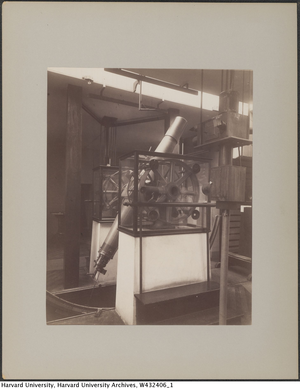

 Fine's Home
Fine's Home